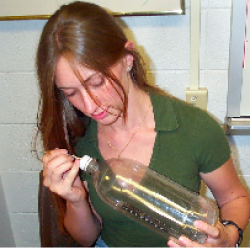Source Institutions
Source Institutions
Add to list Go to activity
Activity link broken? See if it's at the internet archive

This demonstration/activity helps learners understand why higher elevations are not always warm simply because "hot air rises." Learners use a tire pump to increase the pressure and temperature inside a plastic bottle. After the bottle cools to room temperature, learners will release the valve and observe cool air escaping the bottle. Learners will discover that as the air moves to lower pressure, it cools.
- Under 5 minutes
- 10 to 30 minutes
- $1 - $5 per group of students
- Ages 8 - 18
- Activity, Demonstration, Experiment/Lab Activity, Lesson/Lesson Plan
- English
Quick Guide
Materials List (per group of students)
- Two liter bottle
- Tire valve to fit in a cap of bottle (Ace Hardware)
- Bike pump with pressure gauge
- LCD aquarium thermometer (Petco)
Subjects
-
Earth and Space Science
-
Earth Structure
- Atmosphere
-
Earth Structure
-
Physical Sciences
-
Heat and Thermodynamics
- Heat and Temperature
- Heat Transfer
- Thermodynamics and Entropy
- Energy
- Motion and Forces
-
States of Matter
- Gases
- Structure and Properties of Matter
-
Heat and Thermodynamics
-
The Nature of Science
-
The Scientific Process
- Conducting Investigations
-
The Scientific Process
Informal Categories
- Nature and Environment
Audience
To use this activity, learners need to:
- see
- touch
Learning styles supported:
- Involves hands-on or lab activities
Other
This resource is part of:
Access Rights:
- Free access
By:
Rights:
- All rights reserved, Little Shop of Physics, 2009
